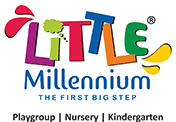
Name Recognition In Preschool
Preschoolers transition through various stages of development and one of them is the egocentric stage. According to the child psychologist, Jean Piaget, “A child has difficulty understanding life from any other perspective than their own. During this period, the child is very me, myself, and I oriented. At this stage the child is unable to see a situation from another person’s point of view. The egocentric child assumes that other people see, hear and feel exactly the same as the child does”.
Hence the “me” at this stage is of prime importance.
No wonder that the first letters of the alphabet that many children recognize are the ones that form their name!
To a preschooler, the most important word in the world is his or her own name. It is personal and it is special.
And that’s exactly what we do with our Little Millennium Preschoolers. We build up on what is so very special and dear to them – their own name!
We try to build in the name games at every step of their early literacy journey. That’s because the name game has a series of benefits:
- Recognising their own name makes children develop a sense of identity and feel good factor
- Reading their own name gives them a sense of accomplishment
- Recognising others’ names help build social skills and a strong sense of community and social belonging
- As caretakers label their bags, books and belongings, it builds a sense of ownership in them. They begin to recognize the fact that they need to look after their belongings
- Art work labeled with the student’s names and displayed around the room evokes a sense of pride in each little artist.
- Cubbies labeled with student’s names mean that each child has a special place to put their belongings. They feel wanted and loved within the classroom space
- It begins the process of sight reading and print recognition
- Finger Painting and sponge dabbing the letters of their names develops the much needed fine motor skills in kindergartners
- Reading their own names kindles a desire within them to try and write their own names. And so they happily begin the act of writing
- And thus begins a joyful journey where these tiny tots try to label their own books , cubbies, pencil boxes and so on
- Recognition of letters of the alphabet leads to reading and reading can inspire writing
So I guess that answers a lot of queries as to why do caregivers at Little Millennium take great pains in putting up the child’s name anywhere and everywhere. On their books, on the Boards, on several charts or window panes, on dining mats and on their tiffin boxes as well.
Additionally, at Little Millennium, we weave in their name in songs, rhymes and stories. This helps the teachers to break ice and build a warm connect with the children. It also makes the children pick up new concepts more easily because the minute you add in their name, it invokes a sense of belonging. Children feel safe and we all know that, only children who are emotionally secure dare to learn more.
- Our Classroom settings have innumerable songs that go like this:
I like the way that Moulik’s reading
I like the way that Meher’s reading
Can you read like that?
Tina Triangle, Tina Triangle,
Look at me, look at me.
Count my sides, count my sides.
There are three, there are three - We introduce our Preschoolers to each other through such energetic Peer introduction songs:
Will you be a friend of mine
Friend of mine, Friend of mine
And dance around with me?
Poorna is a friend of mine,
Friend of mine, Friend of mine
And dances around with me - Our stories are often sung along like this:
Chiku has a birthday, birthday o man
Birthday cake, cake with jam
Chiku has his birthday in the afternoon
All his friends will pay with balloons
The whole idea behind such play is that children should be able to interact with their name by looking for it, dancing with it, moving with it and using it.
Name recognition happens naturally over time. It just takes keeping those names visible and an interactive part of the children’s day. Everyday our children keep looking for their names – on walls, doors, balloons, charts, papers and in the games & stories we play.
Eventually they expand their vocabulary to things and people around them, But this journey begins most happily with their own name.
So dear parents, no harm in putting your children’s names on their cubbies, tables and toys at home.
It helps them belong.
Gradually, they will themselves opt to move on to more complex formations of the letters in the alphabet.
We will be happy to hear more about this from your end!
My teacher put my name
In a special frame
I see it on the cubbies, I see it on the walls
I see it when I run, I see it when I crawl
It’s not for decoration, my teacher told me that
She said I am very special and that is a fact !
